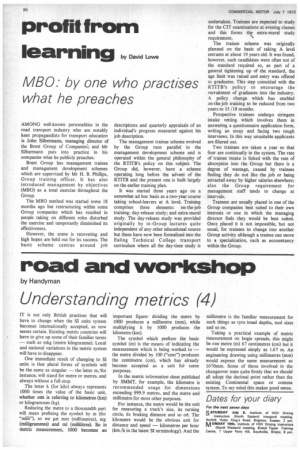road and workshop
Page 92

If you've noticed an error in this article please click here to report it so we can fix it.
by Handyman
Understanding metrics (4)
IT is not only British practices that will have to change when the SI units system becomes internationally accepted, as now seems certain. Existing metric countries will have to give up some of their familiar terms — such as mkg (metre kilogramme). Local and national variations in the metric system will have to disappear.
One immediate result of changing to SI units is that plural forms of symbols will be the same as singular — the letter m,lor instance, will stand for metre or metres, and always without a full stop.
The letter k (for kilo) always represents 1000 times the value of the basic unit, whether orte is referring to kilometres (km) or kilogrammes (kg).
Reducing the metre to a thousandth part will mean prefixing the symbol by m (for "milli"), so we get mm (millimetres), mg (milligrammes) and ml (millilitres). So in metric measurement, 1000 becomes an important figure: dividing the metre by 1000 produces a millimetre (mm), while multiplying it by 1000 produces the kilometre (km).
The symbol which prefixes the basic symbol (m) is the. means of indicating the measurement which is being worked. to — the metre divided by 100 ("cent") produces the centimetre (cm), which has already become accepted as a unit for some purposes.
In the metric information sheet published by SMMT, for example, the kilometre is recommended usage for dimensions exceeding 999.9 metres, and the metre and millimetre for most other purposes.
For instance, the metre would be the unit for measuring a truck's size, its turning circle, its braking distance and so oil. The kilometre would be the obvious unit for distance and speed — kilometres per hour (km-/h in the latest SI terminology). And the millimetre is the familiar measurement for such things as tyre tread depths, tool sizes and so on.
Taking a practical example of metric measurement on bogie spreads, this might be one metre (m) 67 centimetres (cm) but it would be expressed simply as 1.67 m. An engineering drawing using millimetres (mm) would express the same measurement as 1670mm. Some of those involved in the changeover state quite firmly that we should all adopt the decimal point rather than the existing Continental space or comma system. To my mind this makes good sense.
Dates for your diary
For the next seven days SATURDAY July 8. Institute of 'HGV Driving Instructors (South Eastern) inaugural meeting. Norfolk Hotel. King's Road, Brighton, Sussex, 2 pm. MONDAY 10th. Institute of HGV Driving Instructors (South Western) meeting. Bristol Tipper Training Centre, 7 Upper POT/ Hill, Southville, Bristol, 8 pm.
















































































































































